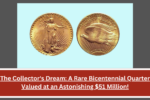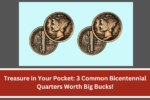In the vibrant world of coin collecting, few items evoke as much excitement as the rare Bicentennial Quarters. Minted in 1976 to celebrate the United States’ 200th anniversary, these coins were produced in massive quantities, leading many to underestimate their worth. However, two exceptional varieties have shattered this misconception, fetching astonishing prices that exceed $100,000 at auction. Join us as we delve into the captivating details of these extraordinary quarters, spotlighting their unique features and the fascinating stories behind their remarkable sales.
The Holy Grail: 1976 No-S Proof Bicentennial Quarter
First on our list is the legendary 1976 No-S Proof Bicentennial Quarter, a true gem in the realm of numismatics. What sets this coin apart is its minting error: it was struck without the “S” mint mark, which indicates it was produced in San Francisco. This rare mistake occurred when a small batch of proof coins was minted using incorrect dies, making it an extraordinary find.
Only a handful of these No-S Proof quarters are known to exist, and they have become a holy grail for serious collectors. One stunning example sold at auction for an eye-popping $270,000, capturing the imaginations of enthusiasts and investors alike. This quarter not only represents a financial investment but also a pivotal piece of American history that embodies the spirit of the Bicentennial celebration.
The Collectors’ Delight: 1976-D Bicentennial Quarter (Double Die)
Next up is the 1976-D Bicentennial Quarter, notable for its fascinating Double Die error. This variety is characterized by noticeable doubling in the inscriptions and intricate details, making it a prized collectible among enthusiasts. While most 1976-D quarters are merely worth their face value, a well-preserved Double Die example has been known to sell for over $150,000. This striking contrast illustrates how a seemingly minor minting error can dramatically elevate a coin’s value, transforming it into a coveted treasure.
The Thrill of Discovery
The astounding sale prices of these rare Bicentennial Quarters highlight the significance of knowledge and research in the dynamic world of coin collecting. While many Bicentennial Quarters may appear commonplace, the distinctive features of the No-S Proof and Double Die varieties demonstrate that hidden treasures often lie within the most unexpected places.
For collectors and casual coin enthusiasts alike, understanding what to look for can lead to significant financial rewards and the exhilarating experience of uncovering a piece of history worth a small fortune. So, as you check your change or explore old coin collections, keep your eyes peeled for these extraordinary gems. You never know when you might stumble upon a valuable treasure that could change your financial future!
FAQ’s
What is a Bicentennial Quarter?
The Bicentennial Quarter is a 25-cent coin minted in 1976 to commemorate the 200th anniversary of the United States Declaration of Independence. It features a unique design that includes the dual date “1776-1976” and was produced in large quantities.
What makes the 1976 No-S Proof Bicentennial Quarter so valuable?
The 1976 No-S Proof Bicentennial Quarter is valuable due to a minting error that resulted in the coin being struck without the “S” mint mark, which indicates it was made in San Francisco. This rare error has led to only a few known examples, with one selling for an astonishing $270,000 at auction.
What is the Double Die error on the 1976-D Bicentennial Quarter?
The Double Die error occurs when a coin is struck multiple times with misaligned dies, causing noticeable doubling in the inscriptions and details. This error makes the 1976-D Bicentennial Quarter highly collectible, with a well-preserved example fetching over $150,000.
What is a Bicentennial Quarter?
- The Bicentennial Quarter is a 25-cent coin minted in 1976 to commemorate the 200th anniversary of the United States Declaration of Independence. It features a unique design that includes the dual date “1776-1976” and was produced in large quantities.
What makes the 1976 No-S Proof Bicentennial Quarter so valuable?
- The 1976 No-S Proof Bicentennial Quarter is valuable due to a minting error that resulted in the coin being struck without the “S” mint mark, which indicates it was made in San Francisco. This rare error has led to only a few known examples, with one selling for an astonishing $270,000 at auction.
What is the Double Die error on the 1976-D Bicentennial Quarter?
- The Double Die error occurs when a coin is struck multiple times with misaligned dies, causing noticeable doubling in the inscriptions and details. This error makes the 1976-D Bicentennial Quarter highly collectible, with a well-preserved example fetching over $150,000.
Are all Bicentennial Quarters valuable?
- No, while most Bicentennial Quarters are worth their face value of 25 cents, rare varieties like the 1976 No-S Proof and the 1976-D Double Die can be worth significantly more. It’s important to identify these specific rare coins to understand their true value.
How can I identify if I have a rare Bicentennial Quarter?
- To identify rare Bicentennial Quarters, look for the following:
- No-S Mint Mark: Check for the absence of the “S” mint mark on the 1976 No-S Proof quarter.
- Double Die Details: Inspect the inscriptions for any signs of doubling, which indicates the Double Die error.
- Condition: The rarity and value of these coins are significantly influenced by their condition, so uncirculated coins are generally worth more.
Thanks For Visiting
Note: Thanks for visiting our website. We are not officials and whatever information we are giving is according to the expected dates. Information will be confirmed in upcoming updates. thank you.
Disclaimer- We are committed to fair and transparent journalism. Our Journalists verify all details before publishing any news. For any issues with our content, please contact us via email.



